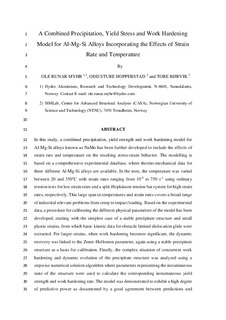A Combined Precipitation, Yield Stress, and Work Hardening Model for Al-Mg-Si Alloys Incorporating the Effects of Strain Rate and Temperature
Journal article, Peer reviewed
Accepted version
Permanent lenke
http://hdl.handle.net/11250/2562619Utgivelsesdato
2018Metadata
Vis full innførselSamlinger
Originalversjon
Metallurgical and Materials Transactions. A. 2018, 49 (8), 3592-3609. 10.1007/s11661-018-4675-3Sammendrag
In this study, a combined precipitation, yield strength, and work hardening model for Al-Mg-Si alloys known as NaMo has been further developed to include the effects of strain rate and temperature on the resulting stress–strain behavior. The extension of the model is based on a comprehensive experimental database, where thermomechanical data for three different Al-Mg-Si alloys are available. In the tests, the temperature was varied between 20 °C and 350 °C with strain rates ranging from 10−6 to 750 s−1 using ordinary tension tests for low strain rates and a split-Hopkinson tension bar system for high strain rates, respectively. This large span in temperatures and strain rates covers a broad range of industrial relevant problems from creep to impact loading. Based on the experimental data, a procedure for calibrating the different physical parameters of the model has been developed, starting with the simplest case of a stable precipitate structure and small plastic strains, from which basic kinetic data for obstacle limited dislocation glide were extracted. For larger strains, when work hardening becomes significant, the dynamic recovery was linked to the Zener-Hollomon parameter, again using a stable precipitate structure as a basis for calibration. Finally, the complex situation of concurrent work hardening and dynamic evolution of the precipitate structure was analyzed using a stepwise numerical solution algorithm where parameters representing the instantaneous state of the structure were used to calculate the corresponding instantaneous yield strength and work hardening rate. The model was demonstrated to exhibit a high degree of predictive power as documented by a good agreement between predictions and measurements, and it is deemed well suited for simulations of thermomechanical processing of Al-Mg-Si alloys where plastic deformation is carried out at various strain rates and temperatures.
